 |
www.shejapan.com > World Heritages > Galapagos
Quiz:
|
|
|
|
私はこのウェブテキスト作るにあたってガラパゴス諸島への理解が深まったと共にそれを人に伝えることの難しさを学びました。みなさんがこのウェブテキストを通じてガラパゴス諸島に少しでも興味をもってもらえると嬉しいです。
<青山学院大学 経済学部 経済学科 柏木広水>
2. ガラパゴスと聞いてどんな動物を思い浮かべますか?
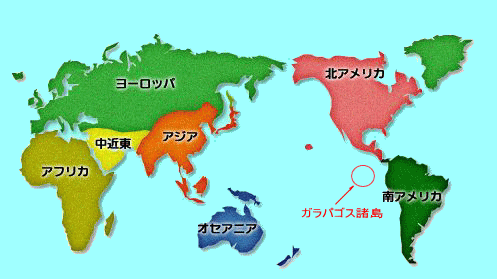
Inscribed :1978
Brief description:
Situated in the Pacific Ocean some 1,000 km from the South American continent, these nineteen islands and the surrounding marine reserve have been called a unique 'living museum and showcase of evolution'. Located at the confluence of three ocean currents, the Galapagos are a 'melting pot' of marine species. Ongoing seismic and volcanic activity reflect the processes that formed the islands. These processes, together with the extreme isolation of the islands, led to the development of unusual animal life - such as the land iguana, the giant tortoise and the many types of finch - that inspired Charles Darwin's theory of evolution following his visit in 1835.
(http://whc.unesco.org/en/list/1/)
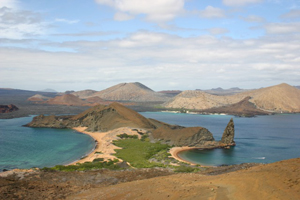 <Geography>
<Geography>
There are 13 large islands, 6 smaller ones and 107 islets and rocks, with a total land area of about 8,000 square kilometres. The islands are volcanic in origin and several volcanoes in the west of the archipelago are still very active. Galapagos is a province of the Republic of Ecuador and five of the islands are inhabited, with a total population of around 18,000 people. The capital is Puerto Baquerizo Moreno on San Cristobal Island, although the largest
town is Puerto Ayora on Santa Cruz.
(http://www.gct.org/intro.html)
<Issues in Galapagos>
Galapagos is a double World Heritage Site (WHS). The land area was among the first natural WHS to be declared in 1978, the marine area was included in 2001. It is the world's largest oceanic archipelago with its biodiversity virtually intact (95%+). Nonetheless, conservation presents many challenges which will only be achieved by a combination of top-quality research and information and by the rigorous implementation of the rules of the Special Law for Galapagos. (http://www.gct.org/issues.html)
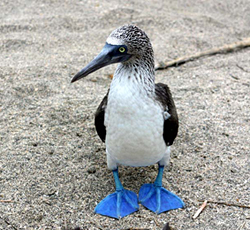
<Scientific expeditions>
Darwin spent five weeks in the Galapagos collecting and preserving specimens from four separate islands. This started the process of enquiry which led him finally to conclusions published in On the Origin of Species by Means of Natural Selection in 1859. Meanwhile, the Ecuadorian colonists had grown in numbers. A series of attempts were made to exploit such crops as orchilla (dyers' moss) and sugar, but none lasted long and several ended violently. Only fishing and subsistence farming on four of the larger islands; Santa Cruz, San Cristobal, Isabela, and Floreana was able to sustain people for long. This resulted in the population growing very slowly so that by 1955 it was only some 1500. The population is now, in 2005, approaching 30,000.
(http://www.gct.org/history.html)
<The future of Galapagos>
Today the islands boast the highest standard of living of any province in Ecuador but, with a rapidly growing population, conflicts have inevitably arisen between the population needs and the fragile Galapagos ecosystem. The pressures on the archipelago's natural resources threaten their biodiversity and ecological integrity, as well as the sustainability of the natural resources upon which the livelihoods of the islanders depend. As the population grows, these pressures are likely to increase rather than decrease. More than ever there is a need for all involved to work together to influence decision makers, in order to preserve these unique and beautiful islands for all their inhabitants and for the world.
(http://www.gct.org/history.html)
1535 スペイン人司教トマス・デ・ベルランガがガラパゴス諸島を発見
1832 エクアドル領となる
1835 チャールズ・ダーウィンが来島
1959 ガラパゴス国立公園設立
1968 ガラパゴス国立公園管理局設立
1969 ガラパゴス諸島の観光が始まる
1978 初のユネスコ世界自然遺産に指定
1998 ガラパゴス特別法制定、ガラパゴス海洋保護区設立
2001 ユネスコ世界自然遺産として海洋保護区を追加
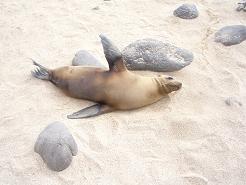
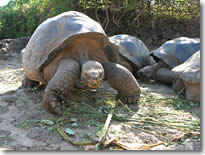
Charles Darwin チャールズ・ダーウィン◆1809-82。英国の博物学者。進化論を提唱。
San Cristobal Island
サン・クリストバル島◆西南太平洋、ソロモン諸島南西部に位置する。
rigorous
厳格{げんかく}な、厳しい
implementation 履行{りこう}、遂行{すいこう}、実施{じっし}、実現{じつげん}、推進{すいしん}
World Heritage
世界遺産
ユネスコ
ガラパゴス観光協会
ダーウィン研究所
www.shejapan.com
> World
Heritages > Galapagos
© Copyright 2006 SheJapan.com. All rights reserved. No reproduction or republication without written permission. Created by Hiromi Kashiwagi